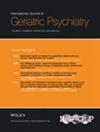Clinical Evolution of Neuropsychiatric Symptoms in Alzheimer's Disease and Dementia With Lewy Bodies in a Post-Mortem Cohort
Abstract
Background
Almost all patients with neurodegenerative dementias experience neuropsychiatric symptoms (NPS) but the timing and clinical course is highly variable.
Methods
In a prospective cohort study in Western Norway, patients with a new diagnosis of mild dementia were assessed annually in the Neuropsychiatric Inventory (NPI) for up to 9 years until death. Patients with post-mortem neuropathological diagnoses of Alzheimer's disease (pAD) (n = 37), Lewy body disease (pLBD) (n = 14) or meeting criteria for both AD and LBD (mixed AD+LBD) (n = 11) were included in this study. Neuropathological assessment was performed according to standardised protocols and blind to clinical information. In mixed effects logistic regression, longitudinal change in NPS was explored across neuropathological diagnoses and substrates. Additionally, the odds of NPS early and late in disease was evaluated in logistic regression.
Results
Early onset hallucinations were significantly more common in pLBD than pAD (OR 0.069 [95% CI 0.012–0.397], p = 0.003) or mixed AD+LBD (OR 0.09 [95% CI 0.010–0.771], p = 0.028) and there was a greater increase in the odds of hallucinations over time in pAD and AD+LBD than pLBD such that there was was no difference in the prevalence of late-onset hallucinations between pLBD, pAD or AD+LBD. Hallucinations early in disease were associated with higher LBD α-synuclein stages and neocortical LBD, in addition and sparser amyloid distribution. Higher density of amyloid plaques, tau tangles, cerebrovascular disease and increasing additional co-pathologies were associated with increasing odds of hallucinations over time.
Conclusions
LBD, without significant comorbid AD pathology, is associated with hallucinations early in the course of disease while multiple other pathologies may be implicated in aetiology of late-onset hallucinations. Hallucinations increase in AD+LBD as disease progresses, a trajectory more closely aligned with AD than LBD.


 求助内容:
求助内容: 应助结果提醒方式:
应助结果提醒方式:


